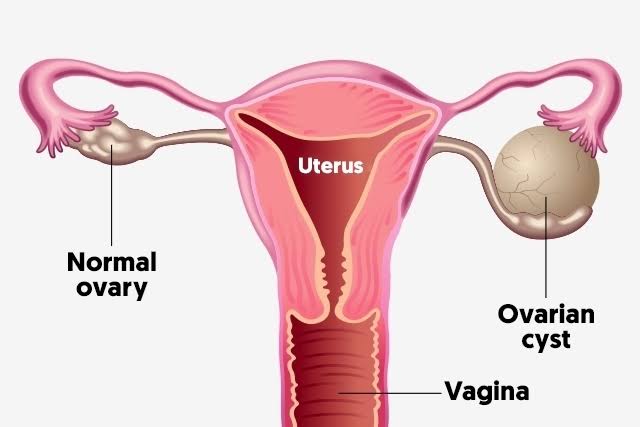- BY Dr. Rajeev's Clinic
- 26-Aug-2019
Ovarian cysts definition and facts
- Ovarian cysts are closed, sac-like structures within the ovary that are filled with a liquid or semisolid substance.
- Ovarian cysts may not cause signs or symptoms. Larger cysts are more likely to cause signs and symptoms such as:
- Pain in the abdomen, pelvis, sometimes radiating to the low back, is the most common symptom
- Feeling of bloating or indigestion
- Increased abdominal girth
- Feeling an urge to have a bowel movement or having difficult, painful bowel movements
- Pain during sexual intercourse (dyspareunia)
- Pain in the lower right or left quadrant of the abdomen on one side
- Nausea and vomiting
What causes ovarian cysts? What are the types of ovarian cysts?
There are many causes of ovarian cysts, and most ovarian cysts are not cancerous.
- Follicular cysts: The most common type is a follicular cyst, which results from the growth of a follicle. A follicle is the normal fluid-filled sac that contains an egg. Follicular cysts form when the follicle grows larger than normal during the menstrual cycle and does not open to release the egg. Usually, follicular cysts resolve on their own over the course of days to months. Follicular cysts can contain blood (hemorrhagic cysts) from leakage of blood into the egg sac.
- Corpus luteum cysts: A Corpus luteum cyst is related to the menstrual cycle. The corpus luteum is an area of tissue within the ovary that occurs after an egg has been released from a follicle. If a pregnancy doesn't occur, the corpus luteum usually breaks down and disappears. It may, however, fill with fluid or blood and persist as a cyst on the ovary. Usually, this cyst is found on only one side, produces no symptoms and resolves spontaneously.
- "Chocolate cysts:" Endometriosis is a condition in which cells that normally grow inside as a lining of the uterus (womb), instead grow outside of the uterus in other locations. The ovary is a common site for endometriosis. When endometriosis involves the ovary, the area of endometrial tissue may grow and bleed over time, forming a blood-filled cyst with red- or brown-colored contents called an endometrioma, sometimes referred to as a "chocolate cyst."
- Polycystic ovarian syndrome: The condition known as polycystic ovarian syndrome (PCOS) is characterized by the presence of multiple small cysts within both ovaries. PCOS is associated with a number of hormonal problems and is the most common cause of infertility in women.
- Dermoid cysts (benign cystic teratomas): Both benign and malignant tumors of the ovary may also be cystic. Occasionally, the tissues of the ovary develop abnormally to form other body tissues such as hair or teeth. Cysts with these abnormal tissues are really tumors called benign cystic teratomas or dermoid cysts.
- Tubo-ovarian abscesses: Infections of the pelvic organs can involve the ovaries and Fallopian tubes. In severe cases, pus-filled cystic spaces may be present on, in, or around the ovary or tubes. These are known as tubo-ovarian abscesses.
What are the signs and symptoms of ovarian cysts?
Most ovarian cysts are never noticed and resolve without women ever realizing that they are there. When a cyst causes symptoms, pain in the abdomen or pelvis is the most common one. The pain can be caused from:
- rupture of the cyst,
- rapid growth and stretching,
- bleeding into the cyst, or
- twisting of the cyst around its blood supply (known as torsion).
If the cyst has reached a large size, other symptoms may arise as a result of pressure or distortion of adjacent anatomical structures. These other symptoms can include
- abdominal fullness, expansion of the abdomen, or bloating,
- low back pain,
- indigestion,
- feeling full after eating only a small amount (early satiety),
- urinary urgency,
- difficulty with emptying the bladder completely,
- feeling an urge to defecate
- having difficult bowel movements, or
- pain with sexual intercourse.
What are the symptoms of a ruptured ovarian cyst?
A ruptured (burst) ovarian cyst will not always cause symptoms, particularly if the cyst is small. However, sometimes a ruptured ovarian cyst can lead to severe pain and internal bleeding. The pain with a ruptured ovarian cyst typically comes on suddenly and occurs on one side only. The pain may begin during physical activity such as vigorous exercise or may begin during sexual intercourse. A ruptured ovarian cyst usually does not cause fever or gastrointestinal symptoms.
Can ovarian cysts cause cancer?
Most ovarian cysts are not due to cancer, and having an ovarian cyst does not cause ovarian cancer. However, some ovarian cancers develop cystic areas inside the tumor. Ovarian cancer is much less common than benign ovarian cysts.
Homoeopathic Medicines for Ovarian Cyst.
1. Apis Mel.
2. Lachesis
3. Pulsatila
4. Thuja
5. Lycopdium
6. AMN



